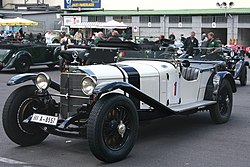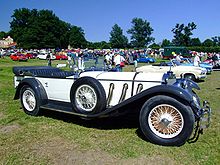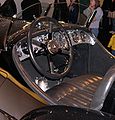Mercedes-Benz W 06
| Mercedes Benz | |
|---|---|
| W 06 | |
| Sales designation: | Type S, type SS, type SSK, type SSKL |
| Production period: | 1926-1932 |
| Class : | Sports car |
| Body versions : | Touring car , cabriolet , roadster |
| Engines: |
Petrol engines : 6.8–7.1 liters (132–221 kW) |
| Length: | 4250-5000 mm |
| Width: | 1700 mm |
| Height: | 1250-1800 mm |
| Wheelbase : | 2950-3400 mm |
| Empty weight : | 1750-2100 kg |
| Previous model | Mercedes model K |
| successor | Mercedes-Benz W 29 |
The Mercedes-Benz W 06 appeared in 1926 as a derivative of the K model from the same year. It is an extremely powerful sports car with a very large six-cylinder engine and compressor . Subsequently, further developed vehicles of this type S appeared with the designations type SS , type SSK and type SSKL .
Mercedes-Benz Type S (1926–1930)
The two and four-seater open vehicles were built on the long chassis with a 3400 mm wheelbase. They could be distinguished from the other Mercedes-Benz models - like their sister model K - by three exhaust hoses leading downwards on the right side of the engine compartment.
The six-cylinder engine has a displacement of 6800 cm³ and a compression ratio of 4.7: 1. It develops an output of 120 hp (88 kW) at 3000 rpm. The engine's overhead camshaft is driven by a vertical shaft. By activating the Roots blower installed at the front , the output can be increased to 180 hp (132 kW) for a short time. This is where the common model name 26/120/180 PS comes from .
Two rising current ring float carburettors supply the engine with petrol. Each cylinder is equipped with two spark plugs ( double ignition ), which are operated both with the vehicle battery and with an ignition magnet . The vehicles have an unsynchronized four-speed gearbox with a center shift that transfers the engine power to the rear wheels. They reach a top speed of 170 km / h.
The vehicles have pressed steel frames made of U-profiles and rigid axles at the front and rear, which are suspended from semi-elliptical leaf springs. All four wheels have drum brakes that are operated with cables.
Mercedes-Benz type SS (W 06, 1928–1934)
Two years later, the successor type SS (Supersport) came out with the same equipment. This vehicle was first run at Daimler-Benz AG under the model number W06. In addition to the chassis and the four-seater sports car, a Cabriolet A and a Cabriolet C were also available. There are different engines:
Model 27/140/200 hp (1928–1930)
The cars have an engine with a displacement of 7065 cm³, which develops 140 hp (103 kW) without and 200 hp (147 kW) with a compressor. The nominal speed is 3300 rpm, the compression is 5.2: 1. With this engine, the cars achieve a top speed of 185 km / h.
Model 27/160/200 hp (1930-1932)
The successor to the aforementioned model differs only in the higher output of 160 hp (118 kW) without a compressor.
Model 27/170/225 hp (1928–1934)
Parallel to the "weaker" models, there was also a version that delivered 170 hp (125 kW) without a compressor with the same displacement and the same nominal speed, which increased to 225 hp (165 kW) when the Roots fan was used . This higher performance was due to the higher compression ratio of 6.2: 1. The top speed increased to 190 km / h.
Mercedes-Benz type SSK (1928–1932)
The most famous cars of this type were built on the short chassis with a 2950 mm wheelbase. "SSK" means "Supersport Short". The Italian racing driver Carlo Felice Trossi made a sketch of how he would imagine an aerodynamically sensible car. An English coachbuilder built a vehicle based on this drawing. The vehicles were delivered either as a chassis or as a sports two-seater. There were also different engines for this model series, some of which correspond to those of the SS type:
Model 27/140/200 PS (W 06 II, 1928–1929)
This motorization corresponds to that of the model with a long chassis. The maximum speed is 180 to 185 km / h, depending on the rear axle ratio.
Model 27/160/200 PS (W 06 II, 1929–1932)
A year earlier than the type SS, the engine with a slightly higher power in naturally aspirated operation was switched to.
Model 27/170/225 hp (W 06 III, 1928–1930)
The more highly compressed and more powerful engine in the short chassis was also available for two years. It ensured a top speed of 188 to 192 km / h, depending on the rear axle ratio.
Model 27/180/250 PS (WS 06, 1929–1930)
In addition to the SS type engines, an even more powerful model with 180 hp (132 kW) in naturally aspirated mode and 250 hp (184 kW) with a supercharger was offered. The performance is at the level of the aforementioned version.
Mercedes-Benz type SSKL (WS 06 RS, 1929–1932)
A racing two-seater was derived from the SSK type and was probably created by converting existing WS 06 wagons. The designation "27/240/300 PS" indicates the power in suction mode (240 PS / 176.5 kW) or in compressor mode (300 PS / 221 kW). These performances are achieved at a nominal speed of 3400 rpm and a compression of 7: 1. The performance in suction mode is only theoretical, as the Roots blower is constantly switched on in these cars .
With a dry weight of 1500 kg, trolleys are approx. 200 kg lighter than the SSK types ("SSKL" means "Supersport short light"). The top speed of this racing car is 235 km / h. The SSKL cost 40,000 RM; that was about nine times as much as the four-door Mercedes-Benz 170 sedan from 1931.
Technical specifications
| model | S 26/120/180 hp | SS 27/140/200 hp | SS 27/160/200 hp | SS 27/170/225 hp | SSK 27/140/200 PS | SSK 27/160/200 PS | SSK 27/170/225 PS | SSK 27/180/250 PS | SSKL 27/240/300 PS |
|---|---|---|---|---|---|---|---|---|---|
| Construction period | 1927-1928 | 1928-1929 | 1930-1933 | 1928-1933 | 1928 | 1929-1932 | 1928-1930 | 1929-1930 | 1931 |
| Motor series | ? | Mercedes-Benz M 06 | |||||||
| Engine type | In-line six-cylinder with water cooling and Roots blower, OHC valve control, one inlet and one outlet valve per cylinder, drive of the camshaft via vertical shaft, two rising flow ring float carburetors | ||||||||
| Working principle | Four-stroke totto | ||||||||
| Bore × stroke | 98 mm × 150 mm | 100 mm × 150 mm | |||||||
| Displacement | 6789 cc | 7069 cc | |||||||
| Nominal power suction | 120 hp (88 kW) at 3000 min -1 | 140 hp (103 kW) at 3300 min -1 | 160 hp (118 kW) at 3300 min -1 | 170 hp (125 kW) at 3300 min -1 | 140 hp (103 kW) at 3300 min -1 | 160 hp (118 kW) at 3300 min -1 | 170 hp (125 kW) at 3300 min -1 | 180 hp (132 kW) at 3300 min -1 | - |
| Rated output with Roots blower | 180 hp (132 kW) at 3000 min -1 | 200 hp (147 kW) at 3300 min -1 | 225 hp (165 kW) at 3300 min -1 | 200 hp (147 kW) at 3300 min -1 | 225 hp (165 kW) at 3300 min -1 | 250 hp (184 kW) at 3300 min -1 | 300 hp (221 kW) at 3400 min -1 | ||
| Maximum torque with Roots blower | 44 kgf · m (431.5 Nm) at 1850 min -1 | 45.9 kgf · m (450 Nm) at 1920 min -1 | 46.2 kg · m (453 Nm) at 1900 min -1 | 45.9 kgf · m (450 Nm) at 1920 min -1 | 46.7 kg · m (458 Nm) at 1900 min -1 | 57.3 kg · m (562 Nm) at 1900 min -1 | 70.2 kg · m (688.5 Nm) at 2,000 min -1 | ||
| Compression ratio | 4.7: 1 | 5.2: 1 | 6.2: 1 | 5.2: 1 | 6.2: 1 | 7.0: 1 | |||
| Fuel tank | 120 l, in the rear | ||||||||
Racing use
From 1927 to 1933, the W 06 vehicles were used in many domestic and foreign competitions. One of the most famous drivers was Rudolf Caracciola . This is how they established the world fame of Daimler-Benz AG as a manufacturer of fast racing and sports vehicles.
Production numbers
A total of just under 300 vehicles of the W 06 model were produced. Several types S were later converted to type SS and several types SS to type SSK. As mentioned above, the type SSKL was probably created exclusively through later conversion of SSK types. Only the original versions are indicated here:
- Type S: approx. 150 pieces
- Type SS: approx. 110 pieces
- Type SSK: approx. 33 pieces
Only a few specimens of the type SSKL were made later; one was operated as a works racing car.
successor
In 1934 these sports cars were replaced by the 500 K model.
Picture gallery
Mercedes-Benz type SSK " Trossi " (1930, bodywork 1934)
literature
- Werner Oswald : Mercedes-Benz Passenger Cars 1886–1986 . Motorbuch-Verlag, Stuttgart 1987, ISBN 3613011336 .
Web links
Individual evidence
- ↑ Mercedes-Benz Public Archive: S 26/120/180 PS
- ↑ a b Mercedes-Benz Public Archive: SS 27/240/200 PS
- ↑ Mercedes-Benz Public Archive: SS 27/170/225 PS
- ↑ a b Mercedes-Benz Public Archive: SSK 27/140/200 PS
- ↑ Mercedes-Benz Public Archive: SSK 27/170/225 PS
- ↑ Mercedes-Benz Public Archive: SSK 27/180/250 PS
- ↑ Mercedes-Benz Public Archive: SSKL 27/240/300 PS
| Vehicle class | 1920s | 1930s | 1940s | ||||||||||||||||
| 6th | 7th | 8th | 9 | 0 | 1 | 2 | 3 | 4th | 5 | 6th | 7th | 8th | 9 | 0 | 1 | 2 | 3 | 4th | |
| Compact class | W 15 (type 170) | ||||||||||||||||||
| W 23 (type 130) | |||||||||||||||||||
| W 30 (type 150) | |||||||||||||||||||
| W 28 (type 170 H) | |||||||||||||||||||
| Middle class | W 02 (type Stuttgart 200) | W 136 / W 149 (types 170 V / 200 V) | |||||||||||||||||
| W 11 (type Stuttgart 260) | W 143 (type 230 n) | ||||||||||||||||||
| W 21 (type 200/230) | W 153 (type 230) | ||||||||||||||||||
| W 138 (type 260 D) | |||||||||||||||||||
| upper middle class | W 03 / W 04 / W 05 (types 300/320/350) | W 18 (type 290) | |||||||||||||||||
| W 10 / W 19 (types 350/370/380) | W 142 (type 320) | ||||||||||||||||||
| W 22 | |||||||||||||||||||
| Upper class | Type 400 & Type 630 | W 24 / W 29 / W 129 (types 500 K / 540 K / 580 K) | |||||||||||||||||
| W 08 (type Nürburg 460/460 K / 500 / type 500 N) | |||||||||||||||||||
| W 07 / W 150 (types 770/770 K) | |||||||||||||||||||
| Sports car | Model K | ||||||||||||||||||
| W 06 (type S / SS / SSK / SSKL) | W 24 / W 29 / W 129 | ||||||||||||||||||
| Off-road vehicle | W 103 (type G1) | W 31 (type G4) | |||||||||||||||||
| W 133 III (type 170 VG) / W 139 (type 170 VL) / W 152 (type G5) | |||||||||||||||||||
| Vans | L 3/4 | L 1000 Express | L 301 | ||||||||||||||||
| L 300 | |||||||||||||||||||
















